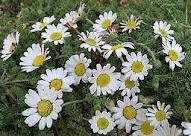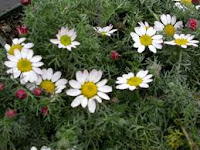Pellitory has been used in medicine since ancient times and originates in Algeria Himalayas (cultivated) and various other parts of the world. It can be used as a herb in stews and so on as it has a peppery taste, perhaps because of the piperine–like substance in it. It is a member of the Asteraceae/Compositae or daisy family so is a relative of marigolds, chamomile, which it resembles closely and a whole host of other flowering plants.
 Dioscorides and Pliny agreed that it was useful against intermittent fevers, while later European herbalists such as Hildegard von Bingen in her “Physica” states that it was used to get rid of waste products in the blood and to build good blood, as well as “for pure intelligence” – I am translating this straight from the Latin and this is all it says. She also writes that it is good when used in cooking for those recovering from a debilitating illness as well as for healthy individuals as it keeps ill-health away. She also says that it clears the head of mucous and clears the eyes, and aids digestion. She describes it as being a temperate herb with a dry warmth and a powerful action.(Perhaps its the European equivalent of the Intellect Tree.)
Dioscorides and Pliny agreed that it was useful against intermittent fevers, while later European herbalists such as Hildegard von Bingen in her “Physica” states that it was used to get rid of waste products in the blood and to build good blood, as well as “for pure intelligence” – I am translating this straight from the Latin and this is all it says. She also writes that it is good when used in cooking for those recovering from a debilitating illness as well as for healthy individuals as it keeps ill-health away. She also says that it clears the head of mucous and clears the eyes, and aids digestion. She describes it as being a temperate herb with a dry warmth and a powerful action.(Perhaps its the European equivalent of the Intellect Tree.) Culpeper writing later in the 17th century agrees in the main: -
 “Government and virtues. It is under the government of Mercury, and I am persuaded it is one of the best purgers of the brain that grows. An ounce of the juice taken in a draught of Muskadel an hour before the fit of the ague comes, it will assuredly drive away the ague at the second or third time taken at the farthest. Either the herb or root dried and chewed in the mouth, purges the brain of phlegmatic humours; thereby not only easing pains in the head and teeth, but also hinders the distilling of the brain upon the lungs and eyes, thereby preventing coughs, phthisicks and consumption, the apoplexy and falling sickness. It is an excellently approved remedy in the lethargy. The powder of the herb or root being snuffed up the nostrils, procures sneezing, and eases the head-ache; being made into an ointment with hog's grease, it takes away black and blue spots occasioned by blows or falls, and helps both the gout and sciatica.”
“Government and virtues. It is under the government of Mercury, and I am persuaded it is one of the best purgers of the brain that grows. An ounce of the juice taken in a draught of Muskadel an hour before the fit of the ague comes, it will assuredly drive away the ague at the second or third time taken at the farthest. Either the herb or root dried and chewed in the mouth, purges the brain of phlegmatic humours; thereby not only easing pains in the head and teeth, but also hinders the distilling of the brain upon the lungs and eyes, thereby preventing coughs, phthisicks and consumption, the apoplexy and falling sickness. It is an excellently approved remedy in the lethargy. The powder of the herb or root being snuffed up the nostrils, procures sneezing, and eases the head-ache; being made into an ointment with hog's grease, it takes away black and blue spots occasioned by blows or falls, and helps both the gout and sciatica.” He also says that it resembles yarrow.
It has also been used as an insecticide and a tonic for the nervous system. In India
 It has been grown in
It has been grown in It has been used as a gargle with cold water and honey to relieve sore throats and relieves the dryness of the mouth and promotes the flow of saliva if chewed. A tincture made from the plant has been used for toothache, either rubbed on the gums or put into a decaying tooth with a cotton wool swab.
The root has been applied as a counter-irritant to joints and limbs afflicted by rheumatism and arthritis and it seems to affect the nerve endings as it causes redness and a tingling sensation. It was once believed that if you chewed the root regularly over a period of several months it would help sufferers of rheumatic and neuralgic pains in the head and face.
The main active ingredient in the volatile oil from pellitory seems to be pyrethrine or pellitorin an alkaloid, along with lignans such as sesamine (also found in sesame seeds), inulin (a starchy substance), and tannins. Lignans such as those found in flax seeds have anti-inflammatory properties.
Research is still being carried out on pellitory so we will have to wait and see what health benefits scientists say this plant has. Probably many of the old uses of the herb will prove to have scientific backing.




Other than using pellitory in cooking may it be used in tea?
ReplyDelete